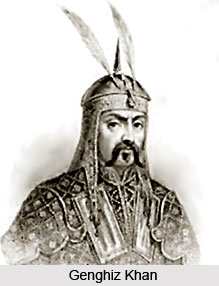 Achievements of Iltutmish were many though he had to face many difficulties after his accession to the throne of Delhi. Iltutmish faced them all with success. Iltutmish defeated Yildiz and Qabacha, the claimants of suzerain power of Delhi, saved Delhi Sultanate from the invasion of the Mongols, conquered Bengal, and tried to break up the power of the Hindu chiefs. Iltutmish ascended an insecure throne but battled all hindrances with courage and vigour and succeeded in overcoming his initial difficulties.
Achievements of Iltutmish were many though he had to face many difficulties after his accession to the throne of Delhi. Iltutmish faced them all with success. Iltutmish defeated Yildiz and Qabacha, the claimants of suzerain power of Delhi, saved Delhi Sultanate from the invasion of the Mongols, conquered Bengal, and tried to break up the power of the Hindu chiefs. Iltutmish ascended an insecure throne but battled all hindrances with courage and vigour and succeeded in overcoming his initial difficulties.
With Yildiz, Iltutmish`s behaviour was most diplomatic. When he ascended the throne, Yildiz had sent him a canopy and a baton which Iltutmish accepted, thus, pretending to recognise his suzerainty. Initially Iltutmish avoided conflict with him and consolidated his position as far as Varanasi. In 1215 A.D. Yildiz was driven out of Ghazni by Khwarizm Shah and he came to Lahore and occupied the territories of Punjab up to Thaneswar. While Yildiz still claimed over lordship over Iltutmish and asked him to send military help, Iltutmish marched against him to settle his score finally with Yildiz. Iltutmish defeated Yildiz in an open battle at Tarain and imprisoned him. He was first sent to Badaun and afterwards killed. Iltutmish`s gain was two-fold. One was that he had killed the most notorious rival to his power and the other was that it led to the final break with Ghazni. From then onwards, the Sultanate of Delhi, became an independent state.
Barely had Iltutmish consolidated his position in Punjab, when his infant kingdom was threatened by a possible invasion of the Mongols. Under the leadership of Genghiz Khan, the Mongols occupied the Khwarizm Empire, forced emperor to flee for safety to the Caspian coast and his heir Jalal-ud-din Mangbarni to Punjab. The Mongols were fiercely pursuing the fleeing prince but stopped at the banks of the River Indus to watch his activities. Jalal-ud-din asked for shelter from Iltutmish, but the later had neither the power nor the desire to confront such a powerful foe. He refused to provide shelter to Jalal-ud-din much against the rules of hospitality. But this wise action of his saved him from the wrath of Genghiz Khan. Jalal-ud-din too realised the futility of fighting against Iltutmish and, therefore, withdrew towards lower Sindh. Thereafter Iltutmish concentrated his power against Qabacha and the Mongols. He defeated Qabacha n Uch and weakened his power. He had saved his kingdom from the Mongol invasion and also from the ill-effects of the politics of Central Asia.
Conquest of Bengal and Bihar
The conquest of Bengal was an important achievement for Iltutmish. After the death of Qutub -Ud -din, Ali Mardan had declared himself as independent and therefore the province of Bengal was lost by the Delhi Sultanate. Iltutmish, being busy in the North West, could not pay attention towards the affairs in Bengal. But as soon as he felt secure in the north-west, he proceeded towards Bengal. Ghiyas-ud-din accepted his suzerainty without fighting and gave him presents. Iltutmish came back after appointing Malik Jani as governor of Bihar. But as soon as Iltutmish turned back Ghiyas-ud-din reasserted independence and turned out Malik Jani from Bihar. Nasir-ud-din, the son of Iltutmish killed Ghiyas-ud-din and Bengal and Bihar again became part of the Delhi Sultanate and remained so till the death of Iltutmish.The modern historians get the clear idea about the position of Bengal and Bihar during the time of Iltutmish from the historical account of Minhaj-i-Siraj called
"Tabaqat-i-Nasiri." After the accession of Bengal by Iltutmish, Tughral Tughan Khan was appointed as the Governor of Bengal.
The Hindu chiefs in Rajputana and Uttar Pradesh had succeeded in recovering a few places from the Turks during the rule of Qutub-Ud-Din Aibak. When Iltutmish ascended the throne they pursued a more aggressive policy and many of them became independent. The Chandellas recovered Kalinjar and Ajaigarh; the Pratiharas occupied Gwalior, the Chauhanas under Govindaraja turned out the Turks from Ranthambhor and occupied Jodhpur and its nearby places. Many other places also witnessed successful revolts of the Rajputs. Iltutmish was determined to recover at least those places which were once conquered by the Turks. Therefore he adopted an aggressive policy against the Hindu chiefs. Ranthambhor was attacked and occupied in 1226 A.D.; Mandor, the capital of the Parmaras, was also recovered; and then Bayana, Thangir, Ajmer, Nagaur and nearby places were conquered. In Uttar Pradesh, Iltutmish succeeded in recovering Badayun, Kannauj, Varanasi, Katehar and Baharaich. Iltutmish certainly could not subdue the power of the Rajputs but was successful in breaking their aggressive strength. He established a firm administration in these recovered territories.
Accession of the title "Sultan"
Iltutmish requested the Khalifa of Baghdad to grant him the title of Sultan. His request was granted and emissaries from the Khalifa reached Delhi with a deed of investiture for Iltutmish in 1228 A.D. This gave Iltutmish a legal claim over the Delhi Sultanate. It also helped him in making his rule hereditary which secured the succession of his children on the throne.






































